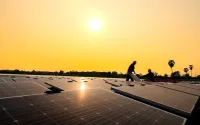January 24, 2011
The world is watching China’s economic surge with understandable awe – while politely and passively ignoring the country’s ecological disintegration.
When the journalist Jonathan Watts was a child, he was told, like so many of us: “If everyone in China jumps at exactly the same time, it will shake the earth off its axis and kill us all.” Three decades later, he stood in the grey sickly smog of Beijing, wheezing and hacking uncontrollably after a short run, and thought – the Chinese jump has begun. He had travelled 100,000 miles criss-crossing China, from the rooftop of Tibet to the deserts of Inner Mongolia and everywhere, he discovered that the Chinese state was embarked on a massive program of environmental destruction. It has turned whole rivers poisonous to the touch, rendered entire areas cancer-ridden, transformed a fertile area twice the size of Britain into desert – and probably even triggered the worst earthquake in living memory.
“The planet’s environmental problems were not made in China, but they are sliding past the point of no return there,” Watts argues in his new book When A Billion Chinese Jump – the essential starting-point for this conversation. The uber-capitalist Communists now have the highest emissions of global warming gases in the world (although the average Chinese person still emits a tenth of the average American). We are all trapped in a greenhouse together: environmental destruction in China becomes environmental destruction where you live. This story will become your story.
So Watts stands in the village in Guandong province where the world’s old motherboards – yours and mine – are sent to die. There, children pick through the old computers, breaking down every reusable part, like they were the globe’s intestine. But the children sicken with lead poisoning, and develop brain damage, cancer, and kidney failure. Even when the kids get to sit in a classroom, they have to wear masks, to protect them from the mountains of garbage.
So he goes to meet the environmental activists who are trying to stop this poisoning of their children, and watches as – terrified – they are carried away to prison. (Imagine if Al Gore had been imprisoned for exposing Love Canal, and was still in solitary, and you get the idea.)
So he ventures out on a ship with an international band of scientists to save the last Yangtze dolphin – an animal that was swimming though China’s rivers 10 million years before the first human, and was a common sight not long ago. But gradually he realises he is too late. They are all dead. He says: “Man had wiped out his first dolphin? The end of a species after twenty million years felt terrifyingly momentous. This was not just a piece of news. It was even more than history. It was an event on a geological timescale.”
So he watches as the globe warms and China’s deserts stretch further and deeper with each passing year. So he stands and stares as the Himalayan glaciers – where most of Asia’s great rivers begin – melt and die, with two thirds on course to vanish by 2050.
This is not an unambiguous story. This destruction is not being pursued out of wickedness: it is happening as a side-effect of a benevolent impulse. The Chinese people are determined to rise from poverty to prosperity. Forty years ago, China was starving. Today, it is in surplus. Some Chinese argue: if environmental damage is the price we pay for whiplash development, why not? You Europeans and Americans destroyed your environments, felled your forests, trashed your habitats all through your Industrial Revolution – and when you were rich enough, you cleaned it up. Yes there is a cost, but it is less than the cost of staying poor forever. How dare you lecture us, when most of our emissions are from factories you have outsourced to make goods and process waste for you, and when you refuse to even make tiny cuts in your emissions are home?
There’s some justice in these responses. Your contribution to global warming (and mine) vastly exceeds the average Chinese person’s. Every successful environmental treaty in history began with the biggest polluters cutting back first. Yet we are refusing to do it, and far from urging China to go green, our governments are doing the opposite. It wasn’t mentioned in the industrial quantities of journalistic hot air that accompanied Hu Jintao’s trip to Washington D.C., but the Obama administration is currently suing the Chinese government at the World Trade Organization to stop them from subsidizing wind farms, saying it represents ‘unfair competition.’ A seventy-a-day smoker riddled with lung cancer isn’t really in a position to lecture a younger man to stop smoking, especially if he’s trying to steal his nicotine patches.
But if this debate dissolves into a game of mutual finger-pointing – you’re the worst! No, you are! – then we will be trapped in a spiral of mutual environmental destruction. The argument that China will simply clean up the damage when they’re rich doesn’t work, alas, for two reasons. Firstly, 700,000 people are dying every year in China as a result of the extreme pollution, according to the World Bank. They can’t be compensated at some later date with a wind farm. Secondly, and even more crucially, the West “cleaned up” largely by exporting its pollution to poor countries like China. As Watts puts it: “This model relied on those at cleanup stage being able to sweep the accumulated dirt of development under a new and bigger rug. When this process reached China, it had already been expanding for two centuries. Now “the waste [is] getting too big and the rug too small.” Where is China going to export it to? For how long?
The alternative is to fuel China’s development (and our own continued existence) with clean energy sources – the mighty power of the wind, the Sun, and the waves. If you believed the gassbaggery of America’s most influential columnist, Thomas Friedman, you’d think it had already happened. He is forever telling readers of the New York Times that China is becoming a ‘green superpower.’ The truth is much more complex. Some 69.5 percent of China’s energy needs come from the dirtiest and most planet-cooking fuel of all: coal. At the same time, the Chinese government is significantly increasing funding for renewables – but as an addition, not a replacement. This is a crucial distinction. If you ate a KFC bucket and a Weightwatcher’s meal for lunch, nobody would say you were on a diet. The Weightwatchers’ has to replace the KFC. In the same way, the renewables have to replace the coal, not just form an additional add-on. That’s not happening today. Not at all: coal burning is increasing.
Partly, this is because the Chinese government has less control than foreign observers assume. Watts says: “China’s political system is neither dictatorship nor democracy. At the top, the state lacks the authority to impose pollution regulations and wildlife conservation laws, while at the bottom citizens lack the democratic tools of a free press, independent courts, and elections to defend their land, air and water.” Inbetween there stand corporations and corrupted local governments bent exclusively on profit and growth, whatever the cost. So “when it comes to protecting the environment, the authority of the authoritarian state looks alarmingly shaky.” Yet at the same time, China’s leaders are – like ours – refusing to pursue the big projects that could haul us out of these dilemmas.
Watts interviews some visionary Chinese scientists who show the real alternative. One of the most fascinating – Professor Li Can, of the Dalian National Laboratory for Clean Energy – shows him how all of China’s country’s energy needs could be met without any carbon emissions at all, using technology that already exists. You would need to cover a third of the Gansu and Xinjiang deserts with photovoltaic solar power cells. It would turn the barren deserts into the country’s greatest asset. There have been similar proposals for harnessing the Sahara to power Europe, and America’s deserts to power the US – but none of our leaders have been visionary enough to do it. So humanity is left largely addicted to the filthy coal of millennia, steadily baking us all.
It’s in the interviews with Chinese environmentalists like Li, and the ordinary victims of eco-destruction, that the question asked most frequently about China books – is it pro- or anti-China? – is exposed as fatuous. Is it ‘anti-China’ to warn the country is driving at high speed into an ecological wall? Is it ‘pro-China’ to cheer that on? Chinese culture is divided – like ours – between the people who want to preserve our
habitat, and the forces of ecocide. This argument has been going on in China for a very long time. As early as the Eastern Zhou period – 700-256 B.C. – there was a saying: “People who are of ruling quality but are not able to respectfully preserve the forests, rivers and marshes are not fit to become rulers.”
In fact, anxiety about ecological destruction is the theme of some of China’s most popular and disturbing recent artworks. The mega-seller novel ‘Wolf Totem’ by Jiang Rong is the story of a young Han Chinese man who is sent to live with the nomads of Inner Mongolia – and watches in horror as his people vandalistically turn the lush grasslands into desert. The movie ‘Still Life’ follows a Sichuanese migrant who returns home after a decade away, only to find his village is empty rubble, about to be flooded for the Three Gorges Dam.
Indeed, the immediate blowback from the country’s casting aside of natural processes becomes most plain when you look at its dams. China has 87,000 mighty steel and concrete dams, directing the nation’s water-supplies along largely man-made routes. The nation will clear away millions of human beings if they are in the way of taming nature in this way. It’s at the centre of the new China’s sense of itself: the current President, Hu Jintao, is a trained hydroengineer. It’s hard not to feel a flicker of awe: they have taken on the oldest rivers and unimaginably vast torrents of water, and for a moment, they seem to have won.
But not for long. By 1980, 2796 dams had failed, with combined death toll of 240,000 people. After the construction of the Three Gorges dam, it soon began to trigger landslides and deadly waves. The rivers feeding it were not able to flush out garbage – so the water became carcinogenic and threatened people in 186 cities. But the most startling effect followed the Zipingpu dam – which may well have caused the Sichuan earthquake.
When the plans were first unveiled to build the Zipingpu dam on an ancient faultline, many scientists warned it was a bad idea. True, the faultline had been dormant for millions of years. But, as Watts puts it: “Each time it filled and emptied, more than 300 million tons of water rose and fell. It was like a giant jumping up and down on a cracked surface. Several leading scientists speculated that the result was a reservoir-induced earthquake.” Less than two years after reservoir first filled, the Sichuan earthquake struck, killing around 68,000 people. Discussion of this question was suppressed in China. But many distinguished scientists have argued that the country’s worst recent “natural” disaster wasn’t natural as all, but a direct result of government policy.
This compresses all the fears about China’s current ecology-trashing binge into one single event, like a dark metaphor. What if you take on nature, and lose? What if your progress today is triggering a catastrophe tomorrow that will leave you worse off than you were in the first place? Yes, a billion Chinese have jumped. If they jump towards renewable energy sources – as their bravest and smartest citizens advocate – they will show humanity how to save itself, and be lauded by future generations as heroes. But at the moment, they are jumping off a cliff.






